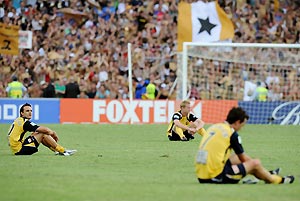
Central Coast Mariners players (L to R) Tom Pendeljak, Matthew Simon and John Hutchinson sit dejected after loosing 0-1 to the Newcastle Jets in the A-League Grand Final in Sydney on Saturday, Feb. 24, 2008. AAP Image/Paul Miller
I recently read that Adam Griffiths had just signed with a Saudi club. An attraction for him was the fact that the side had finished fourth last season and had qualified for the ACL.
Naturally, this got me thinking about our prospects of having four teams qualifying for the ACL, which in turn, inevitably led me to mulling over the question of promotion and relegation.
Now, I know this topic comes up regularly on many forums, so I thought I would use this article to synthesise some of the better ideas I have come across in the blogosphere (including my own, of course).
Assumptions:
1. Promotion and relegation is going to be tough in the Australian context – don’t pay attention to anyone who thinks otherwise. I’m not saying impossible, I’m just saying it will be extremely difficult.
2. The next TV deal will result in an approximate doubling of TV rights from where we are presently (realistic, but by no means a given).
3. The current trend of plenty of bidders for licenses will continue into the foreseeable future, meaning that the A-League could breach 16 teams in four or five years.
Each assumption in turn leads to an important plank of how we get to a promotion and relegation system.
Firstly, why will it be difficult?
Consider what every single club CEO has ever said about the prospects for their club. I will bet you that at some stage or another, they have said something along the following lines: if we can get some success on the field, our future looks bright, and so on.
Does anyone see the obvious paradox in these sorts of statements?
Clearly, in a very young league, with most clubs still struggling to establish themselves, I can tell you right now that if relegation was introduced tomorrow, the first team to be relegated would be as good as dead in the water in terms of its long term viability.
This leads us to the second assumption.
It seems to me that the commercial reality is that even with a doubling of TV rights in a few years time we can choose to either:
a. double salaries; or
b. introduce a second tier,
But we can’t do both. Why?
Because a promotion and relegation system can only work in the Australian context if the second tier is only marginally below the first tier in terms of quality and consequently, access to cash flow.
In other words, the second tier salary cap would need to be around two-thirds of the first tier salary cap, and this immediately tells us that average salaries cannot increase in the same proportion as TV rights because the 2nd tier will need to be subsidised from those TV rights to maintain a relatively high standard (i.e. a standard higher than would otherwise exist if there was no cross-subsidisation).
Now the third assumption: what was the point of mentioning ongoing growth that would take us beyond 16 clubs? To start a comp from scratch with 8, 10 or whatever number of clubs is actually a big ask at the best of times.
For this reason it has occurred to me that if we can achieve steady growth to 16 teams, in that final year where we accept the last two clubs to make up the 16 teams, the FFA would proclaim the commencement of a second tier the following season, on the understanding that the two bottom teams of the current season would be relegated, to be joined by six new teams to form the new second tier.
We would then end up with 14 teams in the A-League, and 8 teams in the First Division (for argument’s sake).
There’s nothing magical about these numbers except to state that a jump in six teams in the one year is about the very tallest order we should be aiming for – anything higher is just too difficult in terms of logistics, in other words, it’s a realistic transition plan.
But make no mistake, even with all of the above occurring (more or less), the second tier would present a major challenge for years to come. I would predict a revolving door of clubs at the bottom of that second tier continuing for decades, maybe forever.
Would we end up with a permanent top three or four clubs as is to be found in the rest of the World?
Not while there’s a salary cap we won’t.
On the contrary, I would envisage a solid big 10 (or so) teams, with three or four at the bottom of the first tier in a constant struggle to stay above, joined by the team newly promoted.
The honest truth is that if we end up with a solid big 10 or so clubs who never experience relegation, the A-League will probably remain more financially secure.
For instance, what good is there for the league to see the Victory’s membership drop from 30,000 to 10,000 if they were ever to experience relegation? Absolutely zero benefit.
The FFA can’t guarantee that won’t happen of course, but it can progress to the sort of environment where that’s unlikely to happen (it’s in its best interests).
Every now and then, we might get a team rising above the morass on a semi-permanent basis, and that’s where the romanticism comes into it for all those new clubs starting out in the 2nd tier.
The reality for most of these clubs, though, is that life will be short and brutish.
That’s what we will have to pay the piper to get our four teams into the ACL.





























































































